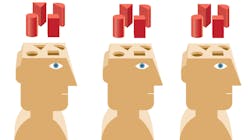Patient-centered to person-centered care: How do we get there?
Editor's note: Winnie Furnari was a continual influence in many of our lives and she became an even stronger influence for me as a chief editor. I always valued her opinion and guidance. Here is the final article she submitted to me for RDH before her passing in April 2023. —Jackie Sanders
Oral health-care providers recognize that systemic health includes the overall mental and physical well-being of individuals. The concept of person-centered care (PCC) has dental providers challenging the status quo. The focus is on the person, not the patient. Health-care providers have been focusing on the people they treat with a time-honored disease-based approach. The shift is now occurring to see this in a different context—a shift from patient-centered to person-centered care.
At times, the terms person-centered and patient-centered are used interchangeably. They have commonalities, yet they have distinct characteristics. The National Academy of Medicine defines patient-centered care as “providing care that is respectful of and responsive to individual patient preferences, needs, and values, and ensuring that patient values guide all clinical decisions.”1 The term is used by the World Health Organization (WHO) and is accepted internationally.2
Read about Winnie Furnari's forensic work: 9/11: Dental hygienists' incredible contributions to identification efforts
A patient-centered model includes a care team that works to know and treat the whole patient. It promotes the development of individualized, comprehensive care plans that include active collaboration and shared decision-making with patients.3
At one time, there was a routine patient care recipe. Health-care professionals followed a predetermined plan that defined procedures. The patient-centered modality treated the patient diagnosis. Using evidence-based practices, the data tell us more about the disease than the person with the disease. It may be characterized as disease-centric or patient-centric.4 People were expected to fit in with the routines and practices that health-care providers deemed appropriate.
What is person-centered care?
There is no one definition of person-centered care. Palatta states, “Person-centered care delivers a multidimensional perspective on the person in relation to his or her disease and overall health and to the environment that surrounds and influences that individual.”4
According to Bau, the individual is embraced as a whole while understanding their daily challenges. This means appreciating oral health desires while ensuring that mental and physical conditions are enveloped within the plan of care. It assures an optimal outcome for long-term maintenance and sustainability regarding goals or needs.1
The most frequently acknowledged attribute of person-centered care is where the clinician considers the unique needs and the specific concerns of the person in order to provide customized interventions.5 This means departing from a biomedical approach and moving to social, mental, emotional, and spiritual needs, while learning individuals’ strengths, weaknesses, preferences, and values.
Person-centered care takes into account people’s preferences and needs, respecting their values and putting them in the center of their care. There should be good communication, information, and education. Family and friends need to be involved. Providers should coordinate and integrate care with continuity.
Person- versus patient-centered care
The distinction between person-centered and patient-centered care may not be clear because they’re closely related. Yet, there are distinct differences between their applications to health care. The concept of PCC has a long history and tradition in health care. Lauver et. al. argued that the origins could be traced back to Florence Nightingale, “who differentiated nursing from medicine by its focus on the patient rather than the disease.”6
Care is not just about providing information or giving people what they want. It’s about considering people’s desires, values, family situations, social circumstances, and lifestyles; seeing the person as an individual; and working together to develop appropriate solutions.7 Services need to be more flexible toward people’s needs in a way that fits those needs.
How we’ve handled prophy patients
The prophylaxis appointment has traditionally been a medical history review, examination, patient education, accretion removal, polishing, radiographs or fluoride treatment, and a four- to six-month recall. If it was determined good oral health was present, home care was discussed, and the patient was put on six-month recall. If it was determined gingivitis was present, there were a whole host of interproximal aids, rinses, and regimens to recommend.
If a patient had periodontal disease, scaling and root planing was performed and the patient was placed on a maintenance recall. Other diagnoses also followed the tried-and-true recipe for prevention, treatment, and home care. It was more about the disease than the person.
The ideal treatment plan is not always practical for patients. Each person has unique circumstances. For those hygienists still following a cookbook plan, there’s a need to move forward and change to incorporate the variations that exist for specialized treatment, especially for people managing disease. Plan and brainstorm in conjunction with the individual. Make plans to support the individual. Focus on the abilities and skills of the person rather than the labels, statistics, and diagnosis.
In order to shift to a person-centered mindset, these should all be considered: ethnics, religion, diet, economics, folklore, traditions, work, family, expressed preference of individuals, and life events. This is about involvement, self-management, self-care, and empowerment.
The shift now is to make these long-time routines secondary and move to the person-centered care. There may be arguments that there are only subtle differences between the two, yet those differences can lead to patients and providers becoming more involved in outcome success and more likely to achieve oral health goals. All health-care professionals need to collaborate, exchange ideas, and learn with and from each other.
Are there consequences?
Walker and Avant noted consequences attributed to PCC. The three primary ones were improved quality of care, increased satisfaction with health care, and improved health outcomes.8 Research has also found that person-centered practice results in good recovery from discomfort and better emotional health in the future.
There are ways a person-centered approach can be intertwined with everyday life for patients. Providers can become knowledgeable about the individuality of patients. When a person’s cultural diet includes heavy amounts of starches and sugars, it’s not person-centered to suggest a diet change. This is an example of recipe treatment. Person-centered accepts the fact that this is not likely a course they will take. Recommendations are always in order, but acceptance is more likely if recommendations such as brushing and rinsing after eating and fluoride applications are in keeping with a person’s cultural practice.
It’s important to think about how to put person-centered care into practice so we can understand the benefits of this approach. It’s an opportunity to improve quality of care and outcomes. There are benefits for those who deliver care, starting with a happier environment. Patients are likelier to become more invested and consistent with their care plans when their needs are addressed. It can improve their long-term interest in their oral health.
The shift to person-centered care has started and many health-care providers endorse this approach. The shift from the perception of oral health from a surgical treatment-oriented approach to one focused on disease management and prevention-oriented primary care comes with several models of care.9 The task is that all health-care providers need to work on being more person-centered.
Editor's note: This article appeared in the July 2023 print edition of RDH magazine. Dental hygienists in North America are eligible for a complimentary print subscription. Sign up here.
References
- Bau I, Logan R, Dezii C, et. al. Patient-centered, integrated health care quality measures could improve health literacy. National Academy of Medicine. February 11, 2019. Accessed March 5, 2023. https://nam.edu/patient-centered-integrated-health-care-quality-measures-could-improve-health-literacy-language-access-and-cultural-competence/
- Barnett N. Person-centred over patient-centred care: not just semantics. The Pharmaceutical Journal. March 29, 2018. Accessed March 5, 2023. https://pharmaceutical-journal.com/article/opinion/person-centred-over-patient-centred-care-not-just-semantics
- What is person centered care: and how can it improve healthcare? Guideway Care. 2020. Accessed March 5, 2023. https://guidewaycare.com/what-is-person-centered-care-and-how-can-it-improve-healthcare/
- Palatta A. Person-centered care the GPS to overall health. J Dent Educ. 2017;81(11):1263-1264.doi:10.21815/JDE.017.083
- McCance TV. Caring in nursing practice: the development of a conceptual framework. Res Theory Nurs Pract. 2003;17(2):101-16. doi: 10.1891/rtnp.17.2.101.53174
- Lauver DR, Ward SE, Heidrich SM, et al. Patient-centered interventions. Res Nurs Health. 2002;25(8):246-255. doi:1002/nur.10044
- What is person-centred care and why is it important? Health Innovation Network. Accessed March 5, 2023. https://healthinnovationnetwork.com/system/ckeditor_assets/attachments/41/what_is_person-centred_care_and_why_is_it_important.pdf
- Walker LO, Avant KC. Strategies for Theory Construction in Nursing. Pearson Prentiss Hall; 2005.
- Lee H, Chalmers N, Brow A, et al. Person-centered care model in dentistry. BMC Oral Health. 2018;18(11):198. doi:10.1186/s12903-018-0661-9
About the Author

Winnie Furnari, MS, RDH, FAADH, FAAFS, FADE
Winnie Furnari, MS, RDH, FAADH, FAAFS, FADE, once served as president of the American Academy of Dental Hygiene. She also served as president of the New York and New Jersey Dental Hygienists Associations and in numerous capacities in professional organizations. She was a clinical professor at NYU College of Dentistry and taught a forensic dentistry/catastrophe preparedness course in the baccalaureate program. Furnari was awarded national and international awards and recognitions for her dental hygiene achievements. As a member of the NY City Dental Identification Team, she participated in several multiple-fatality responses.
